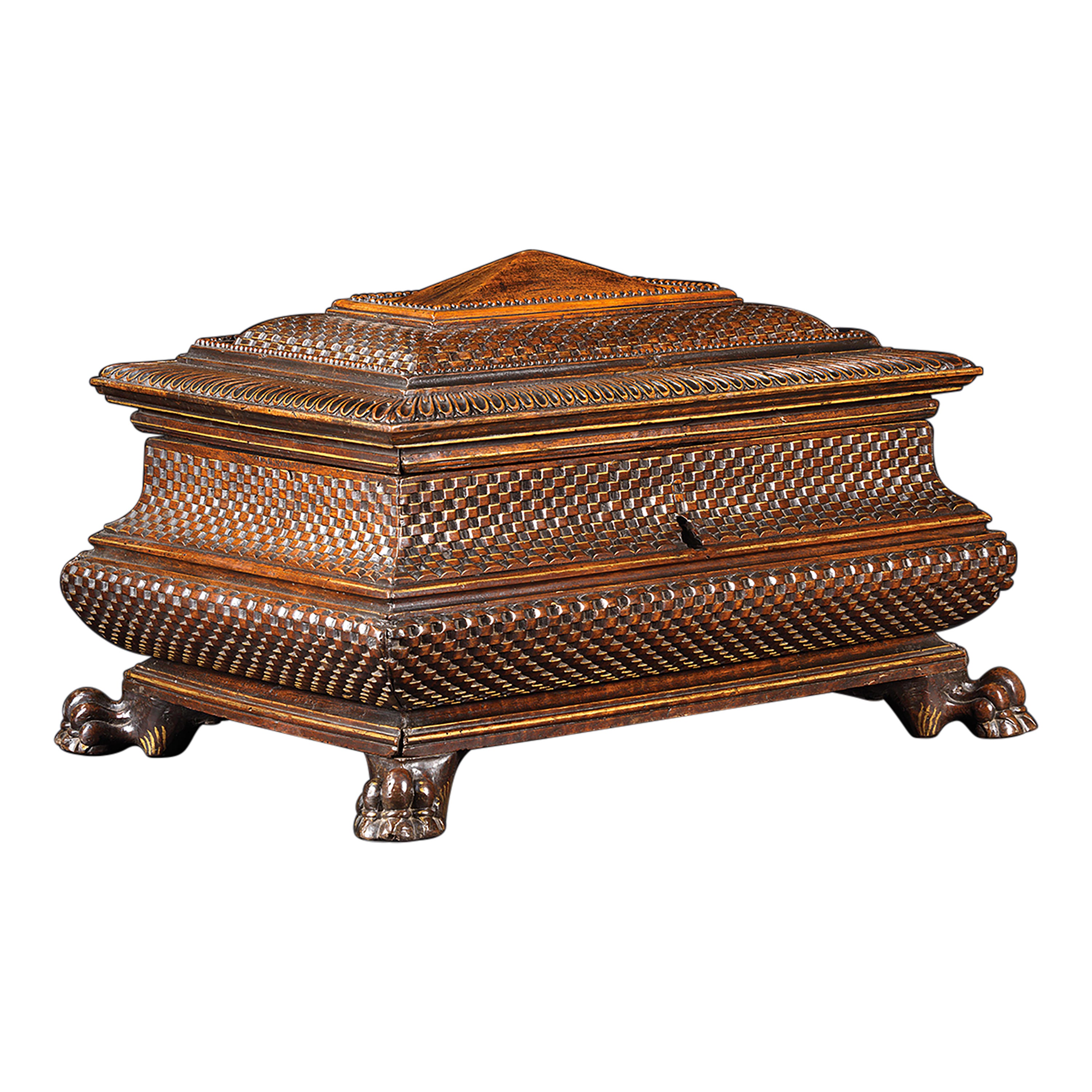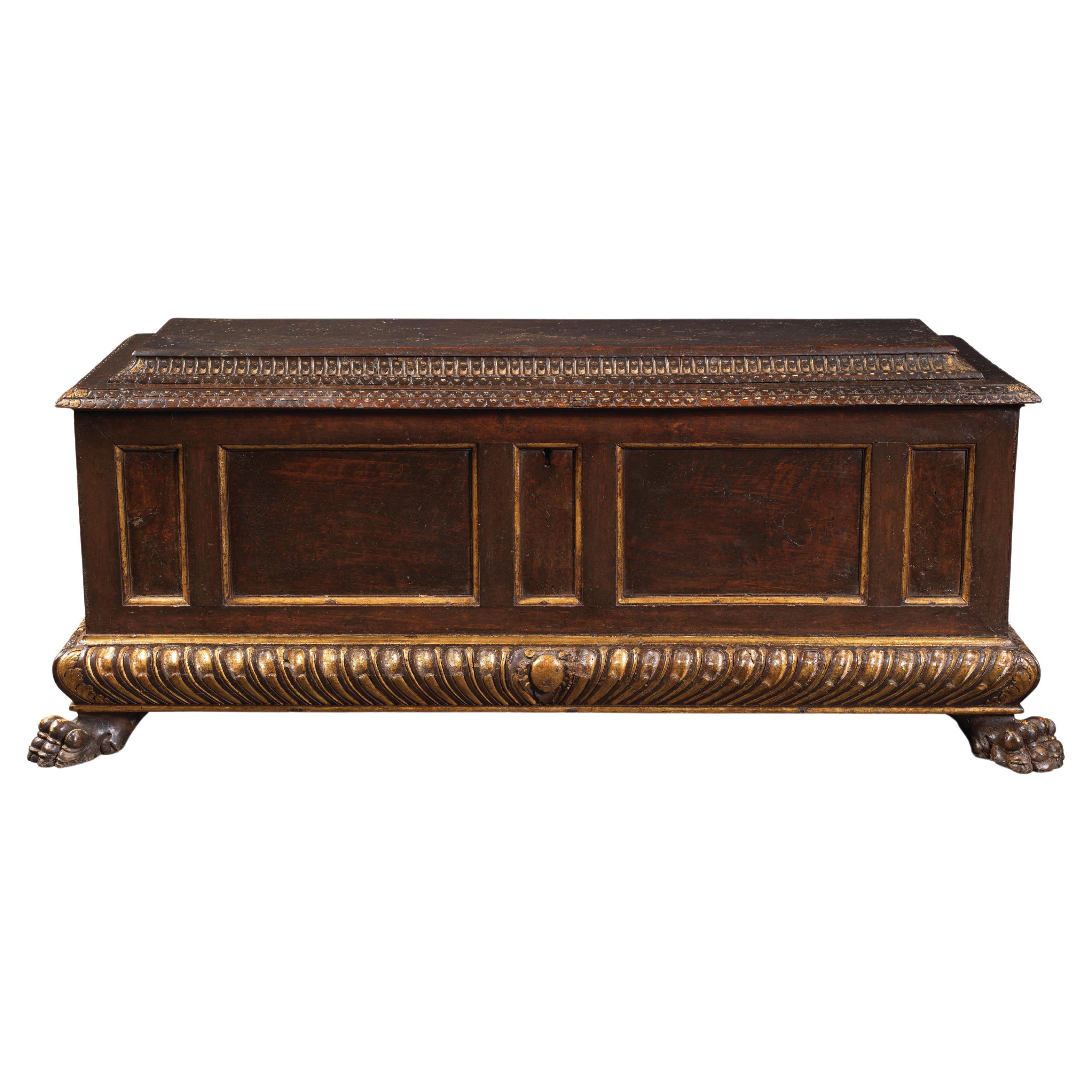Items Similar to 16th Century Gothic Chest, Pinewood, Metal
Want more images or videos?
Request additional images or videos from the seller
1 of 8
16th Century Gothic Chest, Pinewood, Metal
About the Item
The relief of folded cloths was common in the Gothic furniture, coming from Flanders in the 15th century and used in Spain in a common way well into the 16th century, although 17th century examples are preserved that maintain this decorative element. As for wood, although walnut is common in Spanish furniture, it is not unusual to find examples carved in pine wood. Gothic arches can now be found in several prominent museums: the National Archaeological Museum of Madrid preserves four Gothic arches from the 15th century (with Gothic architectural decoration and other carved elements); the Lázaro Galdiano Museum has an Italian example of the 15th century with work of skylights and arches reminding the cloths of Muslim diamonds (Inventory 2141); the Museum of Navarre has a wedding ark of wood and embossed and polychrome leather of the last third of the 15th century (inventory CE000115); etc. The National Museum of Decorative Arts has an oak wood sideboard
(CE01616) decorated with panels "carved" or "parchment", dated circa 1500, and an ark with similar decoration dated between 1476 and 1525 (CE19287)."
Size: 189 x 62 x 90 cms.
- Dimensions:Height: 35.44 in (90 cm)Width: 74.41 in (189 cm)Depth: 24.41 in (62 cm)
- Style:Renaissance (Of the Period)
- Materials and Techniques:
- Place of Origin:
- Period:
- Date of Manufacture:16th Century
- Condition:Wear consistent with age and use. Minor losses. Minor structural damages. Minor fading.
- Seller Location:Madrid, ES
- Reference Number:
About the Seller
4.9
Vetted Seller
These experienced sellers undergo a comprehensive evaluation by our team of in-house experts.
Established in 1985
1stDibs seller since 2017
292 sales on 1stDibs
Typical response time: 16 hours
- ShippingRetrieving quote...Ships From: Madrid, Spain
- Return PolicyThis item cannot be returned.
More From This SellerView All
- Walnut and Metal Chest with Two Locks, 17th CenturyLocated in Madrid, ESRectangular chest with flat top raised on six legs with disc shape finished by moldings. The fronts of the furniture have a smooth area down, a thin molding that is repeated on the t...Category
Antique 17th Century Spanish Baroque Blanket Chests
MaterialsWalnut
- Tabernacle Door, Wood, Metal, 16th CenturyLocated in Madrid, ESThis type of elements are basic in churches, chapels, etc. since they contain the Sacred Forms, reason why it is logical the abundance, with a series of typologies more habitual and traditional or old than others. There are also iconographies more common than others, a certain thematic preference according to the date or school to which the work belongs, etc., always related to the Sacrifice of Christ, Salvation, Transubstantiation, Eucharist, etc. for being a key element for Christianity (especially the Catholic) what they will always contain. The present work shows a chalice with Sacred Form in what would originally be the interior of the door (very usual iconography) and a somewhat more striking relief to the exterior. Inside that it is a Eucharistic Christ or Eucharistic Savior, the way of presenting it is more usual of the scenes of the Last Supper, being not so frequent to find it alone like this. Compare for example with works such as the door of the tabernacle attributed to Alonso Cano...Category
Antique 16th Century Spanish Renaissance Religious Items
MaterialsMetal
- Walnut and Iron Chest, 17th CenturyLocated in Madrid, ESRectangular chest with base and lid with moldings and iron fittings and corners in forge metal on a red cloth background made with stylized and simplif...Category
Antique 17th Century European Baroque Blanket Chests
MaterialsIron
- Wedding Chest, Salamanca Area, Spain, 17th CenturyLocated in Madrid, ESWedding chest. Wood, textile, metal, polychrome. Salamanca, Spain, 17th century. Area of rectangular body with flat top made in carved wood that preserves remains of original polychrome, corners and other metal fittings and textile details in certain places. It is decorated to the outside with a molding in its lower area based on curved motifs and a simple carved decoration of vegetable theme arranged according to a rigid symmetry enhancing an inscription in capital letters on the front ("Viva María / Fernandez") allusive to the owner original of the piece. The interior has no decoration or more elements than the parts of the fittings of the corresponding hinges and the wood seen. The model of a flat-topped ark, with a rectangular shape, was very common in Spanish art as early as the Middle Ages, varying in its decorative elements as time and styles progressed. The metallic elements of the furniture (corner corners on red textile, lock shield on the front, hinges on the inside, handles on the sides to move it, etc.) have a decoration of waves and auctions that refers to models of the Baroque, in addition to columns (flanking the keyhole). The carved decoration of the front (flowers, leaves stems and birds simplified posadas, with simple polychrome in three colors -red, green, yellow-) is not too fine (something usual in popular specimens), and follows a composition and very colorful habitual in the popular coffers of the area of Salamanca, being common the use of walnut for its realization (as in all the Spanish furniture, for the resistance of the wood and its abundance then). The addition of a feminine name in capital letters (detail that would indicate that the present piece of furniture is an ark made to keep a wedding trousseau, hence the abundance of decoration in a popular utilitarian piece and the presence of a lock with a key) is another element to be highlighted in this piece of furniture. Similar model is mentioned in one of the most used reference books of the Spanish furniture, ENRIQUEZ ARRANZ, Maria Dolores. The Spanish furniture in the 15th, 16th and 17th century. 1951. p. 39; cat. no. 74; The m. 74; Beautiful example of chest or ark of bridal, popular Spanish style of century XVII...Category
Antique 17th Century Spanish Baroque Blanket Chests
MaterialsMetal
- Burgalesan Chest, Walnut, Iron, Spain, 17th CenturyLocated in Madrid, ES17th Century Baroque Burgalesan Walnut and Iron Rectangular Spanish Blanket Chest Rectangular chest with a flat lid made of carved walnut wood, with corners and bolts in front to loc...Category
Antique 17th Century Spanish Baroque Blanket Chests
MaterialsIron
- Chest, Walnut, Textile, Wrought Iron, 17th CenturyLocated in Madrid, ESThe shape of this chest, rectangular with flat top, is also the usual in this type of furniture since the Gothic in the Spanish school. It is necessary to highlight the importance that the typology has on Spanish Antique furniture...Category
Antique 17th Century Spanish Baroque Blanket Chests
MaterialsWrought Iron
You May Also Like
- Gothic 16th Century Wood ChestLocated in Barcelona, BarcelonaGothic oak chest from 16th century with paneled lid and 4 linenfold panels in the front, circa 1500-1530 From the low countries, (Netherlands). ...Category
Antique 16th Century Dutch Gothic Blanket Chests
MaterialsWood, Oak
- Late 16th Century Jewelry ChestLocated in Saint-Ouen, FRProvenance : Jean Gismondi collection, before 1973. This important walnut jewelry chest is outlined with a gilt motif and presents a decor imitating basketry. The lid is topped by...Category
Antique 16th Century Italian Renaissance Jewelry Boxes
MaterialsWalnut
- 16th Century, Gothic Oak Chest, Normandy, France, Circa 1500Located in Leominster, GBAn impressive early 16th Century oak coffer, Normandy, circa 1500, having a deep plank hinged top, above a series of four Gothic tracery carved panels...Category
Antique 16th Century French Gothic Blanket Chests
MaterialsOak
- Chest or Stollentruhe, Early 16th Century, German Gothic, Oak Chest, OriginalLocated in BUNGAY, SUFFOLKThis standing chest is of clamp-front construction, extensively decorated with long, ironwork straps with quatrefoil finials which ‘wrap’ around it, and has an ornate, central lockplate, and front legs with full, height stiles. The ironwork straps and finials are fixed with convex, headed nails: running along the front, five long straps; the two side straps; and the five straps on the top. On the chest front, centrally placed, is a large, iron lockplate with four outer, radiating spade finals in each corner and three, superimposed spade finials (a symbol of nobility) which are pierced with the initials ‘BB’. The lockplate receives a corresponding, external hasp fitted to the lid. Below the floor of the chest, the two front stile legs retain most of their original height. The lid is supported by substantial iron strap hinges that extend right down the back of the chest. Inside the chest at the left end is a shallow, oak till. Construction The chest is of joined, 'clamp-front' construction, reinforced by the nailed, iron mounts. In total it uses ten, oak boards which were riven and planed. The back and front are each formed from a large single plank held to the full height stiles by long, pegged tenons. The sides are also single boards joined into the stiles using long tenons held by dowels, and extend down below the chest bottom, concealing the ends of the bottom boards. The bottom consists of a single board cut into the sides and shallow rebates in the stiles. The front and back boards are dowelled into the bottom boards. The lid which overhangs the sides has a narrow cleat at each end, and consists of one wide plank which has bowed a little as a result of shrinkage. Ironwork : The wrought ironwork straps, lockplate, hasp and lock all appear all appear to be early, and of the same original manufacture and are fixed with convex headed nails. There is mild dark staining of the oak around the iron mounts, possibly because of low tannin content in the oak. Length 172 cm., 67 ¾ in., Height 71.5 cm., 28 ¼ in., Depth 63 cm., 24 ¾ in., Related to: No 900:2-1904 V&A Museum, London. Stadtmuseum Dusseldorf. Decorative Arts Museum Berlin. Museen Schleswig-Holstein & Hamburg. A related example featuring elaborately-carved feet and formerly in the Horsham Museum, West Sussex, sold at Christie's in 2010 for £97,250 and another example, again with carved feet sold at Sothebys in 2006 for £48,000. Literature: A similar example is illustrated in H. Lüttgens, Alt- Aachener Wohnkultur; Ein Rundgang durch ein altes Aachener Haus im Wohnstil des 18. Jahrhunderts, Aachen, n.d., ill. 12, and another comparable iron-bound chests...Category
Antique 16th Century German Gothic Blanket Chests
MaterialsOak
- Large 16th Century Tuscan Wedding Chest Called "Cassone"Located in Saint-Ouen, FRLarge wedding chest in tinted and gilded walnut, the lid animated with a frieze of pearls, the sides with compartments, the belt decorated with gadroons. It rests on four claw feets.Category
Antique 16th Century Italian Renaissance Blanket Chests
MaterialsWalnut
- Spanish late Gothic 16th century and later oak coffer / chestLocated in Troy, NYLift top chest with typical carved Gothic tracery work adorning the front panel, of rather small proportion, beautiful color and extraordinary condition...Category
Antique 16th Century French Gothic Blanket Chests
MaterialsOak
Recently Viewed
View AllMore Ways To Browse
Antique Spanish Furniture
Spanish Antique Furniture
Spanish Furniture Antique
Antique Brown Metal
Century 16th
Gothic Furniture Used
Antique Metal Cans
An Antique Chest
Antique Gothic Furniture
Gothic Antique Furniture
Gothic Furniture Antique
From 16th Century
Welling Chest
16th Century Antique Furniture
Paneled Chest
Panel Chest
Metal Office Cabinets Used
Metal Office Cabinet Used





